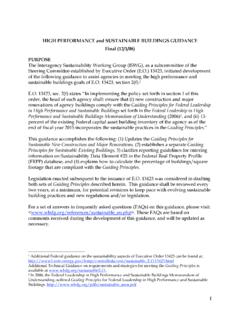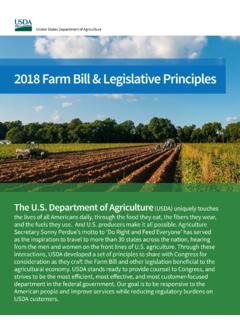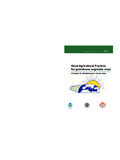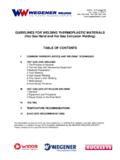Transcription of Water quality and Water quality Management in Aquaculture
1 Water quality and Water quality Management in Aquaculture Aquaculture can be defined as the high-density production of fish, shellfish and plant forms in a controlled environment. Stocking rates for high-density Aquaculture are typically thousand fold greater than wild environments. Modern fish culturists employ both open and close systems to raise fish. Open systems, such as, the raceways (used in hatcheries of both finfish and shellfish and also in eel, trout culture) are characterized by rapid turnover of Water . Closed systems are commonplace in pond culture of carps, catfishes, tilapia, sea bass, prawn and shrimp among others. Closed Aquaculture systems do not have rapid turnover of Water , but do not have a high surface to volume ratio facilitating exchange of gases, nutrients, energy etc. with the surroundings. Such closed system, intensified, high-density Aquaculture forms the basis of concern.
2 The different forms of high density, intensive Aquaculture is quite similar because they all obey the same set of physical and chemical principles. These principles compose the subject of Water chemistry and its net result the Water quality . Poor Water chemistry leads to deteriorate Water quality , which causes stress to the organisms being raised. Efficient feed conversion, growth and marketability of the final product cannot occur unless the pond system is balanced or in harmony with nature. Therefore the overriding concern of the fish culturist is to maintain, balance' or equilibrium conditions' with respect to Water chemistry and its natural consequence, good Water quality . Water quality for aquaculturists refers to the quality of Water that enables successful propagation of the desired organisms. The required Water quality is determined by the specific organisms to be cultured and has many components that are interwoven.
3 Sometimes a component can be dealt with separately, but because of the complex interaction between components, the composition of the total array must be addressed. Growth and survival, which together determine the ultimate yield, are influenced by a number of ecological parameters and managerial practices. High stocking density of fish or crustaceans in ponds usually exacerbates problems with Water quality and sediment deterioration. Wastes generated by Aquaculture activity (faeces and unconsumed feed) first settle in the bottom, as a consequence of organic waste and metabolites of degraded organic matter is accumulated in sediment and Water . Part of the waste is flushed out of the ponds immediately or late after the organic matter has been degraded. Culture of penaeids has become intensified since 1986. In an intensive system of Penaeus monodon culture salinity, pH and dissolved oxygen were the main parameters, which demonstrated fluctuations of , and mg/l respectively.
4 In addition, ammonia-N (un-ionized plus ionized ammonia as nitrogen). increased exponentially with culture period, and jumped to mg/l after 75 days of cultivation. Low dissolved oxygen level is the major limiting Water quality parameter in Aquaculture systems. A critically low dissolved oxygen level occurs in ponds particularly when algal blooms die-off and subsequent decomposition of algal blooms and can cause stress or mortality of prawns in ponds. Chronically low dissolved oxygen levels can reduce growth, feeding and moulting frequency. 1. Another major consequence of Aquaculture production is a high degree of variability in the concentration of dissolved nitrates, nitrites and ammonia. High feeding rates observed in prawn farms lead to eutrophic conditions characterised by substantial phytoplankton blooms. These blooms ultimately senesce and cause rapid increasing in ammonia levels in the ponds.
5 The environmental conditions that create high ammonia concentrations may also cause increases in nitrite concentration. Both ammonia and nitrite can be directly toxic to culture organisms or can induce to sublethal stress in culture populations that results in lowered resistance to diseases. Ammonia accumulates in culture systems following microbial decomposition of organic material and with some fertilization practices. Microbial decomposition leads to low oxygen concentrations. Low dissolved oxygen concentration increases the toxicity of ammonia to culture organisms. In an aqueous ammonia solution unionized ammonia exists in equilibrium with ionized ammonia and hydroxide ions. The unionized form is usually toxic as it has high lipid solubility and it is able to diffuse quite readily across the cell membrane. Ammonia is utilized as energy source by nitrifying bacteria (Nitrasomonas and Nitrobactor) and oxidised it to nitrite and nitrate.
6 The production of brackishwater shrimps, which showed a strong increase in the 70's and 80's, showed a declining trend during 90's in most parts of the world. In general the decrease in shrimp production of Aquaculture is attributed to over intensification, leading to the deterioration of the surrounding environment and of pond Water and pond sediment quality . Stress reduced shrimps' resistance to pathogenic diseases, resulting in mass mortality. Development of Aquaculture activities at a particular site cannot be carried out only by considering planned facilities and the quality of Water on the site at its origin but also on the aspects of Water quality Management . There is a strong relationship between the quality of the Water in the pond and that in the Water -surrounding environment. Degradation of surrounding Water quality will be faster unless proper Water quality Management techniques are not implemented in the ever-increasing Aquaculture system.
7 Aquaculture pond dynamics Aquaculture ponds are a living dynamic systems they exhibits continuous and constant fluctuations. The pond undergoes a vast collection of both chemical reactions and physical changes. Exchange of atmospheric gases including Oxygen (O2 ), nitrogen (N2 ). and Carbon dioxide (CO2 ) with the pond Water are vital to the process of fish metabolism and plant photosynthesis. Inorganic substances (minerals) dissolve from the pond walls and bottom while precipitation of dissolved minerals occurs. Physicals exchanges between the pond its surroundings include absorption of sunlight (radiant energy) to fuel photosynthesis and supply oxygen with in the pond, heat exchange and volume changes caused by evaporation and precipitation (rain). Changes in the volume of a pond are very important as they affect the concentration of dissolved substances and correspondingly requirements for treatment.
8 Hence, the pond dynamics not only depend on its own characters and conditions but also on the surrounding atmospheric weather conditions. Good production from Aquaculture ponds can be achieved when the pond and surroundings make chemical and physical exchanges at a steady state. When all of the processes balance, a state of equilibrium is achieved. Pond equilibrium is the optimum set of conditions for Aquaculture , a state completely in harmony with nature. 2. Water chemistry A guiding principle of Aquaculture is that Water quality and hence efficient production are a direct consequence of good Water chemistry. Water may be considered as a binder' or matrix' in which the dissolved gases, inorganic substances (minerals), as well as organic matter prevails. In addition to dissolved substance, the Water matrix gives support to microorganisms, plant and animal life forms and provides a medium for chemical exchange among these populations.
9 However, Water is itself relatively chemically inert, physically Water has a high heat capacity (holds heat efficiently), is relatively polar' affording it the ability to act as an excellent solvent and is also quite dense. Its boiling point is quite high compared to similar molecules and its freezing point quite low. Therefore, Water exists as a liquid over a rather broad range of temperature making it a most suitable medium for the support of life forms. The maintenance of good Water quality is essential for both survival and optimum growth of culture organisms. The levels of metabolites in pond Water that can have an adverse effect on growth are generally an order of magnitude lower than those tolerated by fishes/prawns/shrimps for survival. Good Water quality is characterized by adequate oxygen and limited levels of metabolites. The culture organisms, algae and microorganisms such as bacteria produce metabolites in a pond.
10 The major source of nutrients in Aquaculture is the feed. Because large quantities of feed are loaded in ponds, excess feed, fecal matter and other metabolites become available in large quantities for the growth of algae and microorganisms. At one point, the increase in population of algae and microorganisms is exponential. This usually occurs during the second half of the culture period because of available nutrients. About 30% of the total feed consumption is loaded into the pond during the third quarter of the culture period and about 50% is loaded during the last quarter. The algae and microbial population increases until a factor required for growth becomes limiting, after which a sudden decrease in the population can occur. This is referred to as a collapse or a die-off . The sudden increase and decrease in algal and microbial population can cause drastic changes in Water quality parameters, which may affect growth.









